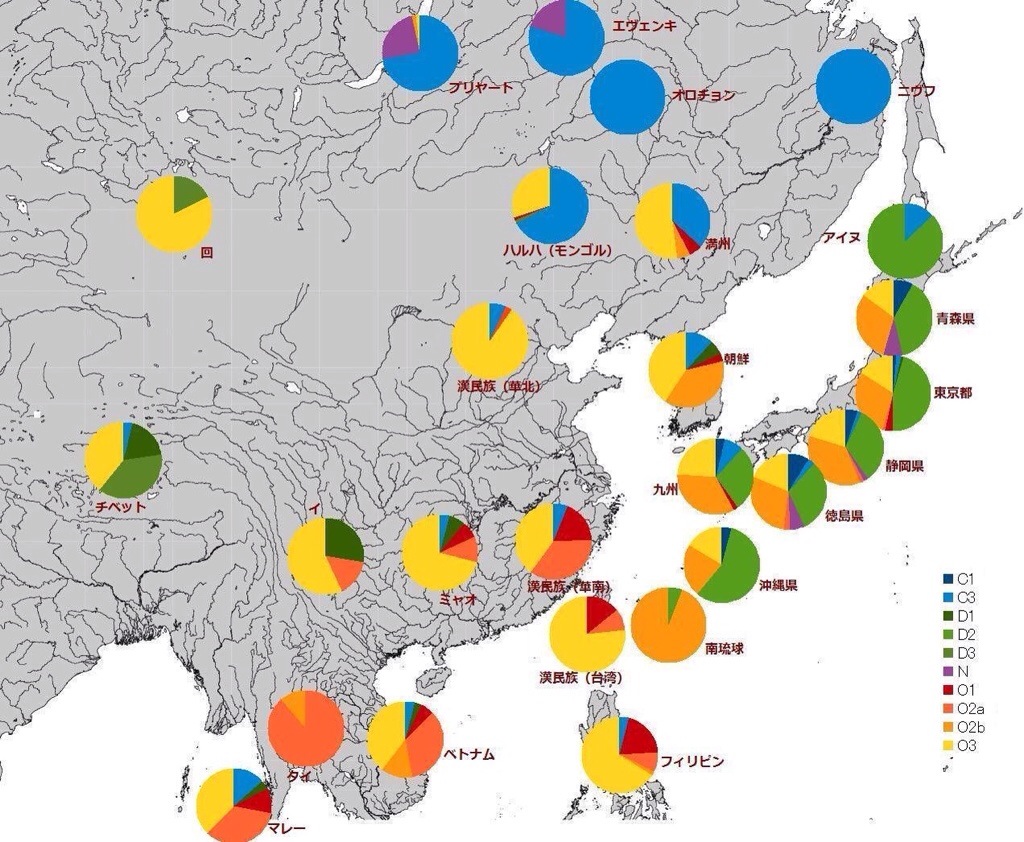Tokyo
Jewish Priests among Cocasians and Japanese among Asians
There are indeed some specific traits in genes and DNA in Jewish people. One of them is Y-chromosome DNA Haplogroup J.
There is a group of genes in an organism that is inherited together from a single parent, and this group called Y-chromosome DNA haplogroup can be used to trace a patrilineage of a man. And the type of Haplogroup J is believed to have evolved in Western Asia and suggest the existence of Y-chromosomal Aaron as the common ancestor of Jewish priests of today, although the Y-chromosome haplogroup originally started to evolve from Haplogroup A.

https://ja.wikipedia.org/wiki/Y%E6%9F%93%E8%89%B2%E4%BD%93%E3%83%8F%E3%83%97%E3%83%AD%E3%82%B0%E3%83%AB%E3%83%BC%E3%83%97
Haplogroup J is found mainly in the Middle East and South-East Europe, and the ratios of those among Jewish people who have this type of genes are as follow:
Haplogroup J
Ashkenazi Cohanim (AC): 87%
Sephardic Cohanim (SC): 75%
Ashkenazi Jews (AI): 37%
Sephardic Jews (SI): 37%
Y-chromosomal Aaron is the name given to the hypothesized most recent common ancestor of the majority of the patrilineal Jewish priestly caste known as Kohanim (singular "Kohen", also spelled "Cohen"). According to the Hebrew Bible, this ancestor was Aaron, the brother of Moses.
Although Jewish identity has, since at least the second century CE, been passed by matrilineal descent according to Orthodox tradition (see: Who is a Jew?), membership in the group that comprises the Jewish priesthood (Kehuna), has been determined by patrilineal descent (see Presumption of priestly descent). Modern Kohanim are regarded in Judaism as male descendants of biblical Aaron, a direct patrilineal descendant of Abraham, according to the lineage recorded in the Tanakh (שמות / Sh'mot/Exodus 6).
Molecular phylogenetics research published in 2013 and 2016 for haplogroup J-M267 places the Y-chromosomal Aaron within subhaplogroup Z18271, age estimate 2638-3280 years Before Present (yBP).
https://en.wikipedia.org/wiki/Y-chromosomal_Aaron#DatingSpecifically distribution of Haplogroup J in the world is as follows:

https://en.wikipedia.org/wiki/Haplogroup_J_(Y-DNA)
In this context, it might be said that Jewish priests of today are really descendants of their Jewish ancestors living in the central part of ancient civilizations of the mankind as indicated by the distribution of Haplogroup J that is believed to have emerged 48,000 years ago.
Furthermore, Y-chromosome DNA haplogroup studies have proved uniqueness of the Japanese race unlike Koreans, Chinese, and other races.
The Japanese race is characterized by a certain Y-chromosome DNA Haplogroup: Y-chromosome D. Haplogroup D is found only in Japan, Tibet (not in the Chinese mainland), the Andaman Islands (in the Bay of Bengal). Especially Haplogroup D1b is found only in Japan. It tells that the Japanese race is inherently different from Koreans, Chinese, and any other races.
Specifically the state of distribution of Y-chromosome D in Asia is as follows:

https://en.wikipedia.org/wiki/Haplogroup_D-M174
More specifically the state of distribution of types of Y-chromosome DNA Haplogroup in East Asia is as follows:

http://tokyox.matrix.jp/wordpress/dna%E3%81%A7%E8%A6%8B%E3%82%8B%E6%97%A5%E6%9C%AC%E4%BA%BA-%E9%81%BA%E4%BC%9D%E5%AD%90%E3%81%AE%E6%83%85%E5%A0%B1/
The thick green in the above distribution circles indicates Haprogroup D1, while the light green indicates Haprogroup D2.
Haprogroup D is believed to have evolved in the regions through Africa, Iran, and Central Asia 60,000 years ago. Although Tibetans and the Andaman Islanders have Haprogroup D, Haprogroup D1b characterizing only Japanese evolved and split from other D types 40,000 years ago. Therefore, it is thought that there is no close relationship between Japanese and Tibetans and the Andaman Islanders at least in these 40,000 years.
This finding suggests that ancestors of the Japanese race reached the Japanese Archipelago before other Asians (the northern type with Haprogroup C and the southern type with Haprogroup O) came to dominate the Chinese continent and East Siberia, and their DNA traits are still dominant among the Japanese.
It also suggests that the Japanese language was established before Chinese and Korean. The grammar of the Japanese language has common traits with some East Siberians' languages, but there are many Japanese words linked to those of Southeast Asians. Probably, there must have been many Asians from Siberia to Southeast Asia who had Haprogroup D like Tibetans and Andaman Islanders, but they must have been overwhelmed by other Asians coming later with Haprogroup C or O. But only Tibetans living in the very high places around Mt. Everest and Andaman Islanders living in remote islands from the Asian continent could preserve Haprogroup D like Japanese living in the east end of Asia.
Accordingly, although Japanese look similar to Koreans, Chinese and other East Asians and share some cultural aspects with them, Japanese are essentially different people from them, although Africans, Europeans, and others with Haprogroup J are essentially more different from East Asians.
In this way, Jewish priests of today are very different from Europeans, other Cocasians, and even other Judaists as they have specific Haprogroup J.
**** ****
Mar 9:12 And he answered and told them, Elias verily cometh first, and restoreth all things; and how it is written of the Son of man, that he must suffer many things, and be set at nought.
Mar 9:13 But I say unto you, That Elias is indeed come, and they have done unto him whatsoever they listed, as it is written of him.

